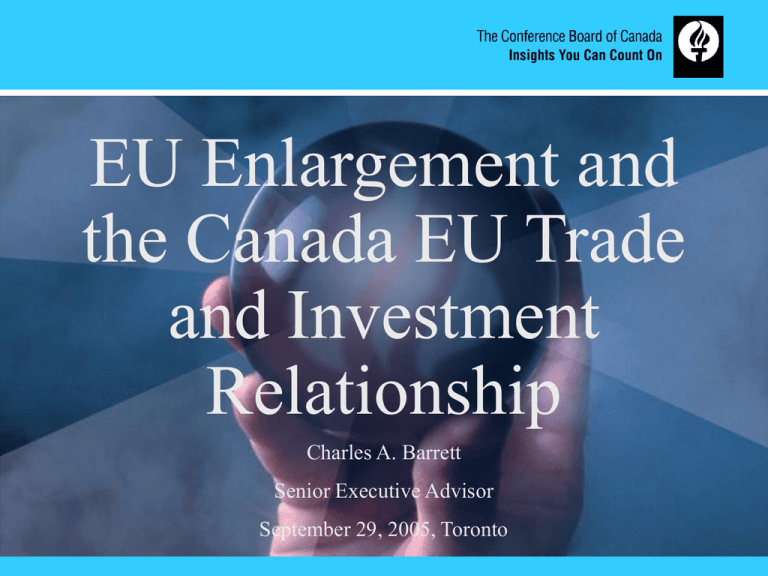Charles Barrett
advertisement

EU Enlargement and the Canada EU Trade and Investment Relationship Charles A. Barrett Senior Executive Advisor September 29, 2005, Toronto www.conferenceboard.ca Canada–EU Relationship Conference Board of Canada Research Report The Conference Board has undertaken a research project to investigate the Canada-EU trade and investment relationship and to examine key challenges especially after EU enlargement. The activities included: • Literature review • Interviews with Canadian and European business • Analysis and recommendations • Final report www.conferenceboard.ca Presentation Overview • Overview of Canada-EU trade and investment trends • Historical development of Canada-EU economic cooperation agreements • Barriers to trade and investment categorized by issue • Concluding remarks www.conferenceboard.ca Overview of Canada-EU Trade and Investment Trends • As a result of EU enlargement, no change in the importance of the EU’s main trading partners • Canada continues to rank 12th in terms of EU trade – Assuming 1.8% of EU trade with third countries • EU ranks as Canada’s 2nd most important trading partner after the United States www.conferenceboard.ca Overview of Canada-EU Trade and Investment Trends • Canada is the 3rd major investor in the EU after the United States and Japan • The EU is one of Canada’s fastest growing investment destinations – Canadians sell less to Europe, but sell more in Europe • European investors less enthusiastic about Canada • EU is the 2nd major investor in Canada accounting for 27% of total FDI in Canada www.conferenceboard.ca Overview of Canada-EU Trade and Investment Trends Canada's Merchandise Trade with EU15 40,000 30,000 20,000 10,000 0 2004 www.conferenceboard.ca 2003 Year 2002 -30,000 2001 -20,000 2000 1999 1998 1997 1996 1995 1994 -10,000 1993 Millions $CDN 50,000 Exports Imports Balance Overview of Canada-EU Trade and Investment Trends Canada's Services Trade with EU15 10,000 Exports Imports Balance 5,000 0 2003 2002 www.conferenceboard.ca 2001 Year 2000 1999 1998 1997 1996 1995 1994 -5,000 1993 Millions $CDN 15,000 Overview of Canada-EU Trade and Investment Trends Canadian Investment Flows with EU15 Canadian Outward Investment in EU15 EU Foreign Direct Investment in Canada Millions $CDN 20000 15000 10000 5000 0 1 2 2001 2002 2003 www.conferenceboard.ca 3 Balance of Outward less Inward Canada-EU Economic Cooperation • Canada and the EU share the common goal of supporting multilateral trade negotiations under the WTO • Canada and the EU have made a number of bilateral agreements to enhance cooperation on trade and investment • Most agreements provide for voluntary cooperation on non-tariff barriers to trade issues www.conferenceboard.ca Canada-EU Economic Cooperation • Bilateral agreements deal with “new trade policy issues” or so-called “behind the border” issues • Canada is only one of eight countries worldwide that does not have a preferential trading relationship with the EU • At various times Canada has proposed a free trade agreement with the EU with no results achieved www.conferenceboard.ca Canada-EU Economic Cooperation • Bilateral agreements include: – 1976 Framework Agreement for Commercial and Economic Cooperation – 1997 Agreement on Customs Cooperation and Mutual Assistance to Customs Matters – 1998 EU-Canada Trade Initiative – 1998 Agreement of Mutual Recognition of Conformity Assessments – 1999 Competition Agreement www.conferenceboard.ca Canada-EU Economic Cooperation • Bilateral agreements cont.: – 1999 Veterinary Agreement – 2003 Agreement on Trade in Wines and Spirits – 2004 Canada-EU Trade and Investment Enhancement Agreement (TIEA) www.conferenceboard.ca Barriers to Trade and Investment • In 2002, ECTI commissioned surveys of EU and Canadian exporters and found that 52% of Canadian goods exporters and 83% of Canadian services exporters found that trade relations with the EU are problem free • The EU business survey also confirmed that most industries find the Canadian market open to EU trade and investment, with only a limited number of barriers www.conferenceboard.ca Barriers to Trade and Investment • Non-tariff barriers–e.g. differences in regulations and standards–are issues that should take precedence over more traditional market access barriers • In contrast to Canadian business responses, a survey of EU businesses revealed limited support for a Canada-EU FTA www.conferenceboard.ca EU Enlargement • The accession of 10 new members to the European Union on May 1, 2004 is the fifth and largest enlargement in the EU’s history • The EU now has over 450 million consumers • The Enlarged EU accounts for 19 per cent of world trade, is the source of 46 per cent of world outward FDI, and hosts 24 per cent of inward FDI www.conferenceboard.ca EU Enlargement • Historically, the 10 new member states have been minor trading partners with Canada – Although recently there has been significant gains in trade activity, increasing by 37 per cent since 2000, whereas Canada’s trade with the rest of the world declined slightly www.conferenceboard.ca EU Enlargement 1500 Canada's Merchandise Trade with EU10 Millions $ CAD 1000 500 0 1995 -500 1996 1997 1998 1999 Total Exports 2000 Total Imports 2002 2003 2004 Trade Balance -1000 Year www.conferenceboard.ca 2001 EU Enlargement • Enlargement will bring positive and negative effects for Canada in the short and longer terms • Negative Effects: – Implementation of EU regulations may be a lengthy process resulting in delays to the regular flow of trade and investment to the new member states – Removal of tariffs to the new member states may result in trade diversion, as demand for goods and services within the enlarged territory increases and prices are reduced because of the tariff-free status www.conferenceboard.ca EU Enlargement • Negative effects cont.: – In the longer term, increased competition may result in imports from Canada and other non-EU countries being displaced by suppliers within the EU www.conferenceboard.ca EU Enlargement • Positive effects: – The potential for trade creation, since the EU is adopting EU commercial policies including a single tariff and international trade policy obligations – The EU is obliged to negotiate with Canada for compensation should accession of the new member states result in an increase in existing tariffs. www.conferenceboard.ca Business Response • Based on interviews with 20 Canadian companies of Canadian and European origin, businesses feel positive about the relationship and the prospects enlargement will bring • However, companies consulted do not believe their business activities in the enlarged EU will significantly enhance their business prospects or result in major growth in trade and investment www.conferenceboard.ca Business Response • Canadian investors are showing less interest in the new member states and concentrating their investments in the EU15 www.conferenceboard.ca Business Response • Many companies either: – had strategies for pursuing opportunities in the new member states prior to enlargement – have a presence and will expand to other new member states – have a presence in the EU15 and will expand to the new member states this will take place within the next 5 years www.conferenceboard.ca Business Response • Companies that indicated they were not going to pursue opportunities in the new member states made their decision based on what they perceived to be a lack of business potential • Opportunities exist in the larger of the new member states, in particular Czech Republic and Poland. www.conferenceboard.ca Business Response • There was an indication of the potential for trade diversion • Canadian companies feel concerned that they will not be able to compete effectively as the markets open up to increased competition • There was agreement that tariffs present minimal barriers to trade, supporting earlier studies www.conferenceboard.ca Business Response • More focus could be spent on non-tariff barriers. The most significant that impact business were: – Mobility of personnel – Mutual recognition of professional standards – Government procurement – Regulatory barriers – standards • These areas have been identified under the TIEA www.conferenceboard.ca Business Response • Those aware of the TIEA consider it to be a positive step in furthering the Canada-EU trade and investment relationship • However, more than half of the businesses were not well aware of the TIEA framework and its objectives www.conferenceboard.ca Business Response • Regulatory cooperation and harmonization should be the key area of focus of the TIEA • For the trade and investment relationship to prosper, there needs to be a political will to pick up the pace of the negotiations of the TIEA www.conferenceboard.ca Concluding Remarks • Overall, the Canada-EU trade and investment relationship is seen as a positive one, with relatively few barriers and with only a small number of isolated disputes arising • The scope for enhancement of Canada-EU cooperation lies in the area of non-tariff barriers to trade, particularly with respect to regulations and standards, competition policy and government procurement www.conferenceboard.ca Concluding Remarks • Increasing cooperation between Canada and the EU includes increasing internal policy coherence and coordination by both parties – For Canada, it means enhancing federal and provincial cooperation, and clarifying issues of jurisdiction that impact on trade and investment policy issues – For the EU, it involves increased harmonisation and cooperation among EU members, especially with respect to new member states www.conferenceboard.ca Concluding Remarks • The TIEA should bring the cooperation frameworks together under one umbrella agreement providing more formalized mechanisms for dialogue • As the TIEA is a “gentlemen’s agreement” rather than a formal undertaking such as the WTO, the nature of how this mechanism could be used to resolve differences would be quite different, providing a forum for the clarification of understanding and negotiation of specific issues www.conferenceboard.ca Concluding Remarks • Of concern is business’ lack of knowledge of the TIEA • Negotiation of the TIEA needs to take into account the individual relationships of both parties with the United States • Canada-EU cooperation needs to continue to find common goals that will be accepted for trading partners in the multilateral arena www.conferenceboard.ca www.conferenceboard.ca









